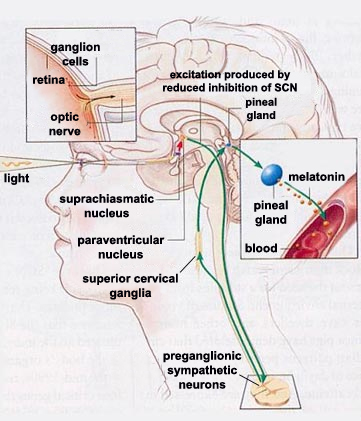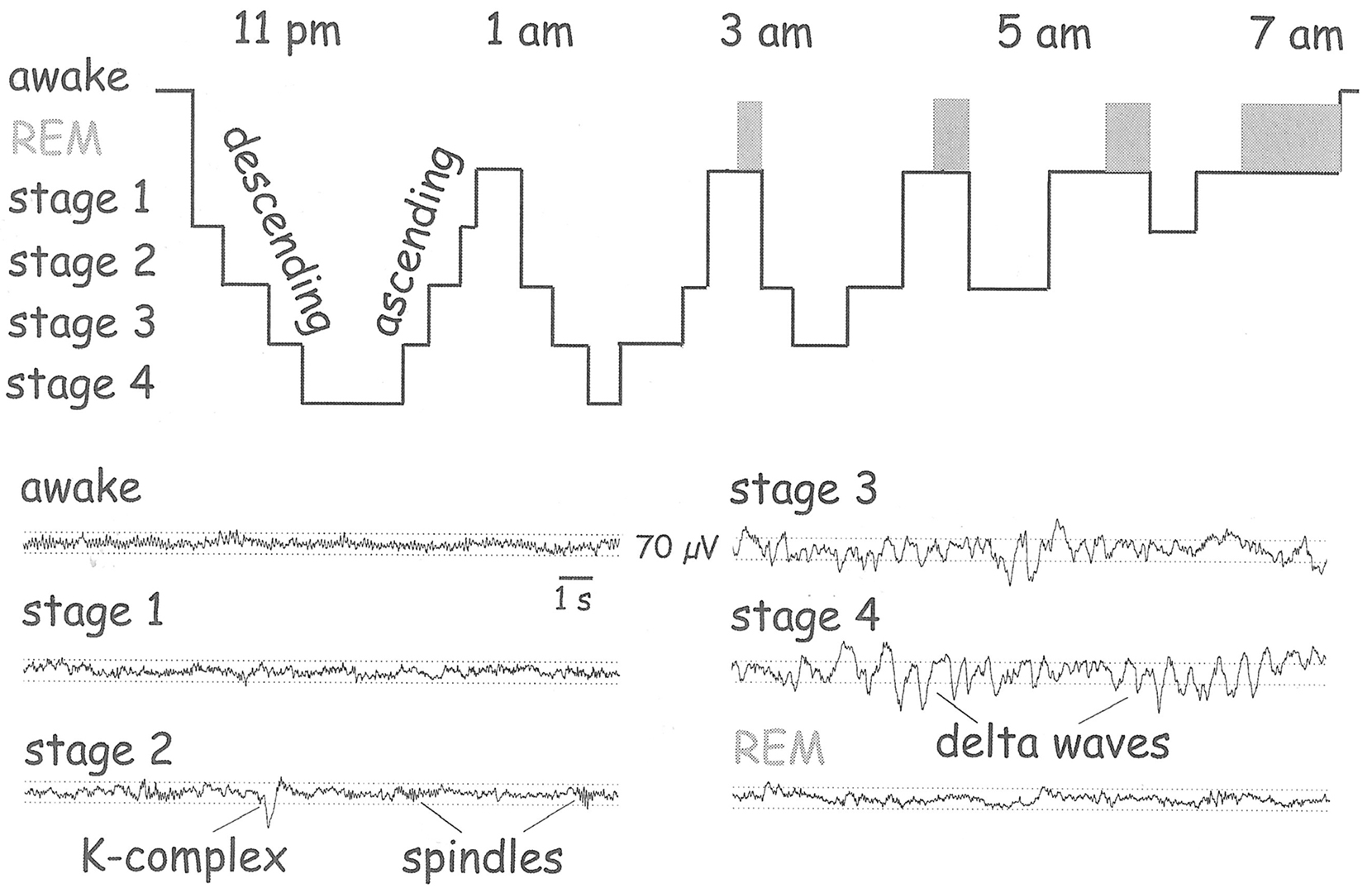- Sleep – Get some!
- Your brain needs it
2017-02-24 10:19:34
Prelude
Today's Topics
- Biological rhythms
- To sleep, perchance to dream…
I got rhythm…
- Rhythms operate at multiple time scales
- Ultradian (> 1x day)
- 90-110 min cycles of heart rate, day dreaming
- Circadian
- Diurnal vs. noctural
Biological rhythms
- Infradian (< 1x day)
- Menstrual or estrus cycles
- Circannual
Factors influencing rhythms
- Endogenous factors
- Internal oscillator or “clock”
- “Free-running”
- Exogenous factors
- “Zeitgeber” or “time-givers” reset clock (entrainment)
- Or, independent of clock
Mechanisms of biological timekeeping
- Endogenous
- Cellular, neural oscillators
- Genetic, hormonal variations
- Exogenous (external to organism)
- Light
- Temperature
- Sound
Physiological mechanisms
- Pineal gland & melatonin
- Suprachiasmatic nucleus (SCN) of the hypothalamus
SCN Figure
Pineal gland & melatonin
- Pineal gland
- Input from SCN via sympathetic NS
- Melatonin
- Secretion peaks at bedtime
- Controls hibernation in some species
Pineal gland figure
Sleep
- The structure of sleep
- The neuroscience of sleep
- Why do we sleep?
Structure of sleep
- cyclic, has phases
- 90-110 min cycles
Sleep structure figure
Sleep phases
Neuroscience of sleep
- Electroencephalogram (EEG) evidence
- EEG frequency bands
- Delta: 1-4 Hz
- Theta: 4-8 Hz
- Alpha: 8-12 Hz
- Beta: 13-30 Hz
- Gamma: >30-50 Hz
Sleep stages and EEG
Awake state
- EEG
- Low amplitude
- High frequency
- Beta band: attentive state
- Alpha band: quiet rest
Stage 1 and 2
- Stage 1
- Drowsy, don’t feel asleep
- Theta wave
- Stage 2
- Sleep spindles (12-14 Hz bursts)
- K complexes
Slow-wave sleep (Stages 3 & 4)
- EEG
- Synchronized
- Delta wave (1-4 Hz)
- Groggy if awoken
- Rarely report vivid dreaming
Sleep EEG figure
Rapid Eye Movement (REM) Sleep
- ~ 20% of sleep
- Desynchronized EEG
- Similar to Stage 1
More on REM sleep
- Muscular paralysis except eyes
- Vivid dream state
- Cortex activity > awake state
- “Paradoxical” sleep
REM sleep atonia circuit
Brain systems and sleep
- Basal forebrain
- Induces slow-wave sleep via GABA release?
- Hypothalamus
- Coordinates between other areas
- Orexin/hypocretin
- Thalamus
- Reticular nucleus
Thalamocortical circuits
Other structures and their functions
- Pons
- Triggers REM sleep
- NE projection from Locus Coeruleus
- Induces muscle atonia via strong GABA, glycine activation
Inducing sleep
Sleep and development
- Sleeping like a baby
- Babies sleep 70% of the time
- Mostly in REM
- But, no stable pattern before 3.5-4 mos
- Sleep disorders common in elderly
Sleep and development
Sleeping around the animal kingdom
- Highly variable patterns
- Mammals and birds show SWS & REM
Why do we sleep?
- Animals with higher metabolic rate -> more sleep
- Avoid predators
- Conserve energy
- Restore body
- Growth hormones released, but
- Amount of exercise unrelated to sleep duration
- Consolidate learning & memory
Sleep, Learning & Memory
Main points
References
Diekelmann, Susanne, and Jan Born. 2010. “The Memory Function of Sleep.” Nature Reviews Neuroscience 11 (2). Nature Publishing Group: 114–26. doi:10.1038/nrn2762.
Hobson, J Allan, and Edward F Pace-Schott. 2002. “The Cognitive Neuroscience of Sleep: Neuronal Systems, Consciousness and Learning.” Nature Reviews Neuroscience 3 (9). Nature Publishing Group: 679–93. doi:10.1038/nrn915.
Klemm, WR. 2011. “Why Does Rem Sleep Occur? A Wake-up Hypothesis.” Frontiers in Systems Neuroscience 5. Frontiers Media SA. doi:10.3389/fnsys.2011.00073.
McGregor, Ronald, and Jerome M Siegel. 2010. “Illuminating the Locus Coeruleus: Control of Posture and Arousal.” Nature Neuroscience 13 (12). Nature Publishing Group: 1448–9. doi:10.1038/nn1210-1448.
Peplow, Mark. 2013. “Structure: The Anatomy of Sleep.” Nature 497 (7450). Nature Publishing Group: S2–S3. doi:10.1038/497S2a.










